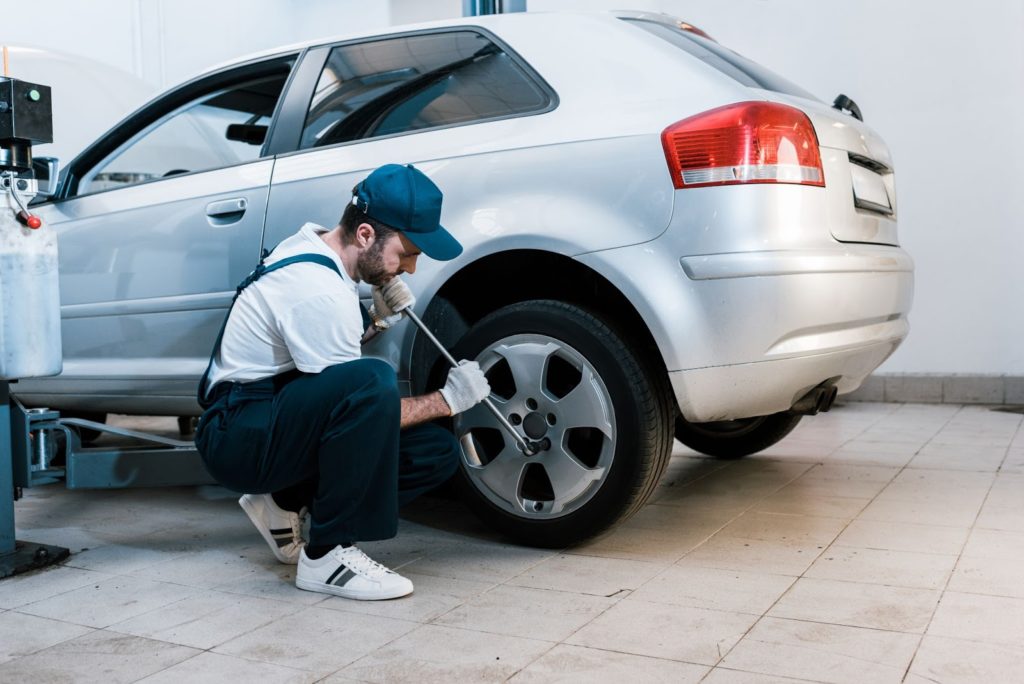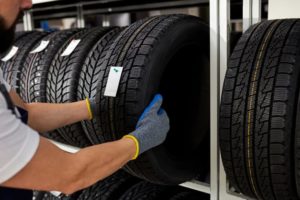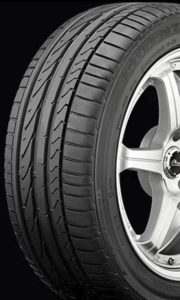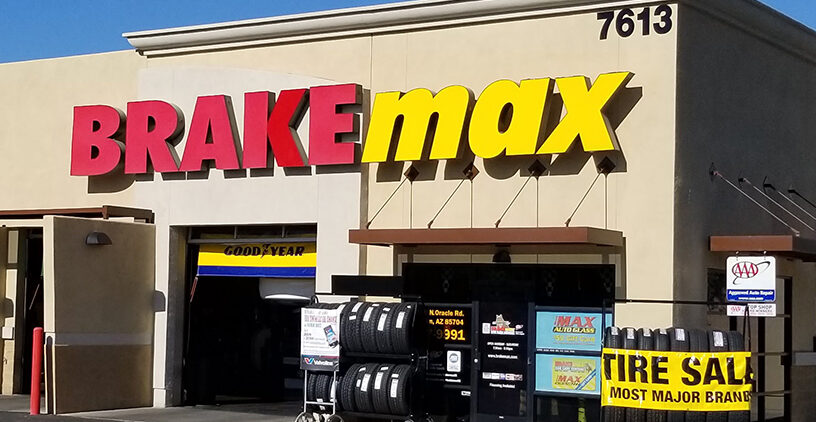Tire Shop Guide: How To Pick The Best Tires For Your Car

When you need new tires, going into a local tire shop in Tucson and trying to sort through the variety of options can be overwhelming. If you want the best tires for your vehicle, just picking the first tire you see on display is probably not going to work.
In this guide, we’ll show you how to get started and help you narrow down the options to select the best new tires for your car, truck, or SUV. Once you’re informed about the different types of tires available and what needs to be considered, it can help ensure that you leave with high-quality tires that meet your unique driving needs.
Things To Consider When Choosing Tires
Tires may all look very similar, but it’s important to select tires that not only fit your vehicle, but also your specific needs. There are a variety of types available (see more on that below) that are optimized to perform under different usages and in different conditions.
To help you narrow down your options, we advise you to consider the following:
- The weather conditions you drive in: Keep in mind the conditions you drive in the most and the worst weather situations you may face. You will need tires that can safely perform in those weather environments.
- The types of roads you’ll be driving on the most: Long highways, city streets, dirt roads, and muddy trails all require different tire characteristics.
- Your normal driving style: Do you appreciate high-performance driving that hugs the corners, or count on a relaxed and cushioned ride?
- The required tire diameter for your vehicle: No matter what type of tire you choose, it needs to fit the required tire diameter of your current wheels. This can be found either on the vehicle information sticker on the inside of your driver’s side door, or within the numbers on the sidewall of your current tires.
The Different Types Of Tires Available
The engineering specifications of most tire types on the market today are based on road conditions and/or driving habits. Once you have an idea of the specific handling and environmental characteristics you’ll need from your tires, you can look at the types of tires that will match those. This will help you narrow down options even further.
For guidance, you can use the recap of each of the tire types below to pinpoint which ones best suit your location and performance needs. Many of these tire types are available in a variety of sizes to fit cars, SUVs, trucks, crossovers, and minivans:
- Summer tires: Sometimes referred to as “regular” tires in our area, summer tires perform best in warm climates and provide excellent traction on damp roads, making them a great option for many Tucson area drivers. These tires also offer more performance and grip than all-season tires, but don’t expect to safely drive in snow with these tires. In freezing temperatures, the soft rubber of summer tires hardens quickly, making them unsuitable for driving in cold environments.
- All-season tires: All-season tires, as the name suggests, are built for high performance in almost any type of weather. These tires have a very good tread life, are fuel-efficient, and provide a quiet, smooth ride. All-season tires can also provide traction in light snow, but do not perform as well in extreme winter conditions. They can’t handle ice, thick snow, and sub-zero
 temperatures like snow tires can.
temperatures like snow tires can. - High-performance tires: High-performance tires were engineered specifically for high-performance sports cars. These tires, often slightly wider than other types, provide superior driving performance through turns, easily handle high speeds, and grip the road like race tires. But, high-performance tires do have a lower treadwear rating, compared to other types of tires and typically won’t last nearly as long.
- Touring tires: For drivers who want premium tires that provide superior handling, a smooth and comfortable ride, and minimal road-noise, touring tires are the answer. These tires also provide a long tread life and reliability. Like summer tires, touring tires perform very well in the typical dry and wet conditions, but they will not safely perform in extreme weather conditions that include freezing temperatures, ice, or snow.
- All-terrain tires: All-terrain tires are the perfect choice for drivers who enjoy taking their truck or SUV off-road occasionally, as well. These tires have an overall beefier appearance and deeper tread depths, allowing them to perform well in all types of off-road surfaces, including sand, rocks, and even mud. But when all-terrain tires are driven on the highway and normal roadways, they will still offer the handling and comfort that everyday “on-road” tires provide.
- Mud-terrain tires: If you drive your vehicle off-road in tricky conditions, mud-terrain tires are going to be the best option. With their deep rugged tread pattern, these tires are built to easily handle deep mud and soft sand better than any other type of tire. But, because of their design, these tires won’t provide as smooth or quiet of a ride on normal roads like other tire types.
- Snow tires: Though they’re not needed much at all here in the Tucson area, snow tires are built for vehicles driven in cold weather climates. These tires can easily handle the extreme winter environments that all-season tires cannot. Snow tires provide excellent traction in tough winter road conditions like ice, deep snow, and slush. They are engineered using a special rubber compound that will not harden in freezing temperatures.
- Spare tires: If you are buying new tires, don’t forget to also consider your spare tire. This will be crucial in the event you unexpectedly end up with a flat tire. Spare tires can be purchased as either a full-size tire or a compact tire. A full-size spare tire will essentially be a fifth tire for your vehicle. This replacement tire will keep you covered for the long term, if one of your main tires were to fail. Alternatively, a compact spare tire simply acts as a temporary solution that should only be driven on long enough to get you to the tire shop for a new tire.
In the event you are thinking about upgrading to a different tire size or different type of tire, it is highly recommended to first consult with experts in a professional tire store (like BRAKEmax Tire & Service Centers). Our manufacturer-trained technicians can help ensure that you go with new tires that will properly fit your wheels, while not jeopardizing your vehicle’s handling, steering, ground clearance, etc.
You Can Trust Our Tire Shop Experts For Help With New Tires
By considering your tire needs and the types of tires that are available, you’ll have a better idea of what might be the best tires for your vehicle. When you are searching for the top tire stores in Tucson, look no further than BRAKEmax Tire & Service Centers!
At all of our locations, you’ll find tire experts who can answer any tire questions you may have, help you weed through the options available, and pinpoint the best tires for your vehicle that will meet your needs. Make sure to also check out and take advantage of our latest tire deals available.
At BRAKEmax Tire & Service Centers, you can count on our ASE-certified master technicians to expertly handle any other auto maintenance or repair needs your vehicle may have. Tucson area drivers trust the professionals at BRAKEmax for top-quality auto service at prices that can’t be beaten, while still providing unmatched customer service.
Schedule your appointment online today!
Tire Shop FAQs
What Do the Numbers on the Side Of My Tires Mean?
The combination of numbers and letters that run along the sidewall of your tires identifies the tire type and size information. The first letter denotes the type. A “P” means it is a passenger tire and “LT” means it is a light truck tire.
The next three numbers that appear before the slash denote the width of the tire tread (section width). Then, the two numbers after the slash and before the “R” denote the sidewall height (aspect ratio). This is expressed as the percentage of the tire tread that is the sidewall. The larger this number, the larger the sidewall of the tire is.
Finally, the tire’s rim diameter in inches is the last two numbers after the “R”.
So, for example, if the set of numbers on your tire was P235/60R18 then:
It is a passenger tire
The section width = 235mm
The aspect ratio = 60% of 235mm. So the sidewall height would be 141mm
The diameter of the rim = 18 inches
If you’ve got more questions about reading your tires, are searching for options for new tires in Tucson, or need other tire services, we can help!
The experts at any one of our tire shop locations near you can answer any questions you have and help you determine the right tires for your vehicle. Make sure to also check out our latest tire deals to help you save even more money on new tires.
Why Is There Such a Price Difference Between Some New Tires?
Several factors affect the cost of tires and cause some brands and types of tires to be more expensive than others. Aside from the basic cost of raw materials, advances in the design and production of tires all impact the price. These include things like using new materials, improvements in rubber chemistry, and even advancement in rubber mixing technology all impact the price.
These things also impact the tire’s performance during stopping or turning the vehicle in different driving and weather conditions. Simply put, more expensive materials and better-designed tires equal higher prices.
Is There a Downside to Changing the Size of My Tires?
Upsizing or downsizing your tires is one way to change the look of your vehicle. But, it can impact overall performance and your vehicle’s handling.
When you change to a larger, taller tire, the tire will be spinning fewer revolutions per mile. So, your speedometer will display a speed that’s slower than you are actually going. In this case, the speedometer will need to be recalibrated. Also, you may experience a difference in the way the vehicle handles as well as more road noise. You’ll also need to take into account the clearance you have within the wheel well of your vehicle.
Changing to smaller tires to lower the profile of your vehicle will alter its handling, as well as how much clearance you have over speedbumps, hills, etc.
Before you change the size of your current tires/wheels, talk to a tire expert here at BRAKEmax Tire & Service Centers about the pros and cons in regards to your specific vehicle. We will be able to determine what the differences in tire revolution per mile, speed rating, and load index will mean for your vehicle’s bodywork, suspension, and more.
What Is Tire Balancing?
Another way to extend the life of your tires is to ensure they are properly balanced on the wheel. Tire balancing ensures that the weight is distributed evenly around the entire circumference of the wheel unit, resulting in the smooth ride you are looking for. If the weight is not even, the tire tread will quickly wear down unevenly (sometimes in a cupped pattern) and you may even notice a vibration in the steering wheel or floorboard.
This service will happen when you are having new tires installed and can be done as a preventative maintenance service. When balancing is done, the wheel/tire units are mounted on special computerized equipment, imbalances are corrected with small weights on the rim, and the wheel/tire unit is remounted onto the vehicle.
Why Are Regular Tire Rotations Important?
Having a tire rotation done regularly is another service that ensures even tire wear and helps extend the life of your tires. Unequal tire wear can reduce your fuel economy and cause other tread issues or tire repair needs which can then cause safety problems.
If your tires are fairly new, we recommend that they are rotated at the 5,000-mile mark. This is because new tires have a deeper tread that is more susceptible to uneven wear.
Older tires should be on a rotation schedule of every 6,000 to 8,000 miles to ensure even wear and maximize tire life. A good habit to get into is having your tires checked and rotated at the same time that you are bringing your vehicle in for your routine oil and filter change.
What Else Can I Do to Protect My Tires?
- Visually inspect your tires regularly. Look for nails or punctures in the tread or sidewall, uneven or excessive wear, or anything out of the ordinary.
- Make sure you are comfortable using a tire pressure gauge and check your tire pressure regularly, especially when preparing for a road trip.
- When driving, avoid hard corners, fast braking or starts, potholes, or driving over debris in the road.
- Be aware of what your tires’ load capacity is and observe it to prevent tire overheating.
- Set up a schedule for regular tire rotations, pressure checks, and tire balancing at BRAKEmax Tire and Service Centers.
What Are Some Basic Tire-Related Terms I Should Know?
When you are in a tire shop, you may hear some of these common terms:
Tread: The outer grooved surface of the tire that meets the road. Tread patterns will vary between brands and between different types of tires depending on their use. The tread of all-season tires will look very different compared to an off-road tire. If your tire’s tread looks worn or cracked, it’s time to head to a local tire store for a replacement.
Rim: Sometimes also referred to as the wheel, this is the heavy, round metal piece that the tire surrounds. The rim is attached to the axle with lug nuts that screw onto the center bolts.
P-number: This is the “P” at the beginning of the chain of numbers and letters on the sidewall of specifically passenger tires. This first letter indicates the type of vehicle that the particular tire is best suited for.
PSI: This abbreviation stands for “pounds per square inch,” which is the way tire air pressure is measured. You’ll usually find a manufacturer-recommended PSI number stamped on the tire’s sidewall close to the center rim.
How Can I Tell If It’s Time For New Tires?
Inspect your tires regularly. Look for signs of damage and wear, including:
- Cracks in the sidewalls
- Embedded objects
- Tread wear
- Bulges, blisters and other weak spots
If you see any of these signs, or are feeling more vibration than usual when driving, it’s time for a tire shop appointment. BRAKEmax offers all of the tire services and repairs you need, from tire rotation to wheel balancing. We also have great deals on quality tires, plus financing options when you use your BRAKEmax VIP CFNA credit card or Goodyear credit card.









